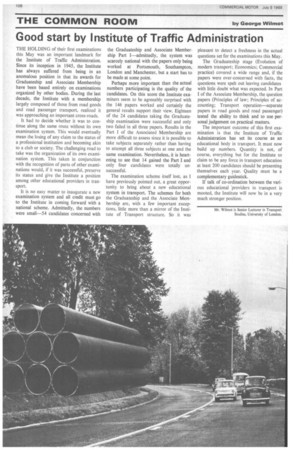Good start by Institute of Traffic Administration
Page 110

If you've noticed an error in this article please click here to report it so we can fix it.
THE HOLDING of their first examinations this May was an important landmark for the Institute of Traffic Administration. Since its inception in 1945, the Institute has always suffered from being in an anomalous position in that its awards for Graduateship and Associate Membership have been based entirely on examinations organized by other bodies. During the last decade, the Institute with a membership largely composed of those from road goods and road passenger transport, realized it was approaching an important cross-roads.
It had to decide whether it was to continue along the same route without its own examination system. This would eventually mean the losing of any claim to the status of a professional institution and becoming akin to a club or society. The challenging road to take was the organization of its own examination system. This taken in conjunction with the recognition of parts of other examinations would, if it was successful, preserve its status and give the Institute a position among other educational providers in transport.
It is no easy matter to inaugurate a new examination system and all credit must go to the Institute in coming forward with a national scheme. Admittedly, the numbers were small-54 candidates concerned with
the Graduateship and Associate Membership Part I—admittedly, the system was scarcely national with the papers only being worked at Portsmouth, Southampton, London and Manchester, but a start has to be made at some point.
Perhaps more important than the actual numbers participating is the quality of the candidates. On this score the Institute examiners seem to be agreeably surprised with the 146 papers worked and certainly the general results support their view. Eighteen of the 24 candidates taking the Graduateship examination were successful and only two failed in all three papers. Results in the Part I of the Associated Membership are more difficult to assess since it is possible to take subjects separately rather than having to attempt all three subjects at one and the same examination. Nevertheless, it is heartening to see that 14 gained the Part I and only four candidates were totally unsuccessful.
The examination scheme itself lost, as I have previously pointed out, a great opportunity to bring about a new educational system in transport. The schemes for both the Graduateship and the Associate Membership are, with a few important exceptions, little more than a mirror of the Institute of Transport structure. So it was
pleasant to detect a freshness in the actual questions set for the examinations this May.
The Graduateship stage (Evolution of modern transport; Economics; Commercial practice) covered a wide range and, if the papers were over-concerned with facts, the questions were spelt out leaving candidates with little doubt what was expected. In Part I of the Associate Membership, the question papers (Principles of law; Principles of accounting; Transport operation—separate papers in road goods and road passenger) tested the ability to think and to use personal judgement on practical matters.
The important outcome of this first examination is that the Institute of Traffic Administration has set its course as an educational body in transport. It must now build up numbers. Quantity is not, of course, everything but for the Institute to claim to be any force in transport education at least 200 candidates should be presenting themselves each year. Quality must be a complementary guidestick.
If talk of co-ordination between the various educational 'providers in transport is mooted, the Institute will now be in a very much stronger position.
























































































































































